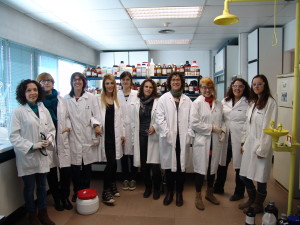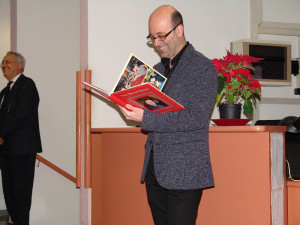Author: Albert Moreno
Video entrega Premi Ciutat de Barcelona a T. Puig y X. Obradors “per la seva aportació en el camp de l’energia elèctrica”
Written by Albert Moreno on . Posted in News.
Day of Women and Girls in Science 2016
Written by Albert Moreno on . Posted in News.
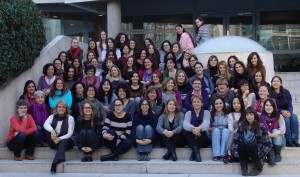
11 DE FEBRERO, DÍA INTERNACIONAL DE LA MUJER Y LA NIÑA EN LA CIENCIA
Written by Albert Moreno on . Posted in News.
3 February 2016: Bernat Bozzo’s PhD thesis defense
Written by Albert Moreno on . Posted in News.
Teresa Puig i Xavier Obradors, Premi Ciutat de Barcelona “pel descobriment d’un procediment de producció de materials superconductors assequible i industrialitzable”
Written by Albert Moreno on . Posted in News.
 Ciències experimentals i tecnologia: a Teresa Puig i Xavier Obradors “pel descobriment d’un procediment de producció de materials superconductors assequible i industrialitzable, basat en la cristal·lització ultraràpida, aplicable a la gestió sostenible de l’energia elèctrica”.
http://www.ara.cat/cultura/Preston-Esquirol-Atrapa-Ciutat-Barcelona_0_1516048478.html
Ciències experimentals i tecnologia: a Teresa Puig i Xavier Obradors “pel descobriment d’un procediment de producció de materials superconductors assequible i industrialitzable, basat en la cristal·lització ultraràpida, aplicable a la gestió sostenible de l’energia elèctrica”.
http://www.ara.cat/cultura/Preston-Esquirol-Atrapa-Ciutat-Barcelona_0_1516048478.html
Solution design for low-fluorine trifluoroacetate route to YBa2Cu3O7 films
Written by Albert Moreno on . Posted in Scientific Highlights.
 X Palmer, C Pop, H Eloussifi, B Villarejo, P Roura, J Farjas, A Calleja, A Palau, X Obradors,T Puig, and S Ricart, Supercond. Sci. Technol. 29 (2016) 024002 (11pp)
doi:10.1088/0953-2048/29/2/024002
We present our work in the preparation of metallorganic precursor solutions with reduced fluorine content, able to fulfil the requirements for high-performance superconducting YBCO epitaxial layers as a promising approach to low cost and scalable coated conductors. Six different solutions using different quantities of fluorine and non-fluorine carboxylate precursors with a total amount of fluorine from 10 to 50% that of standard trifluoroacetic acid (TFA) solutions. For stabilization purposes different coordinating agents have been used and the solution rheology has been modified for proper substrate wettability. Thermal decomposition analysis and infrared spectroscopy performed directly in films, have revealed that the decomposition takes place in two consecutive stages around 265 and 310 °C respectively, and nuclear magnetic resonance (NMR) analysis could unveil the chemical reactions taking place in the solution. Using the solutions with 20% fluorine and upon optimization of the growth process parameters, YBCO layers with Tc andJc(77 K) of 90 K and 4 MA cm−2 are obtained.
X Palmer, C Pop, H Eloussifi, B Villarejo, P Roura, J Farjas, A Calleja, A Palau, X Obradors,T Puig, and S Ricart, Supercond. Sci. Technol. 29 (2016) 024002 (11pp)
doi:10.1088/0953-2048/29/2/024002
We present our work in the preparation of metallorganic precursor solutions with reduced fluorine content, able to fulfil the requirements for high-performance superconducting YBCO epitaxial layers as a promising approach to low cost and scalable coated conductors. Six different solutions using different quantities of fluorine and non-fluorine carboxylate precursors with a total amount of fluorine from 10 to 50% that of standard trifluoroacetic acid (TFA) solutions. For stabilization purposes different coordinating agents have been used and the solution rheology has been modified for proper substrate wettability. Thermal decomposition analysis and infrared spectroscopy performed directly in films, have revealed that the decomposition takes place in two consecutive stages around 265 and 310 °C respectively, and nuclear magnetic resonance (NMR) analysis could unveil the chemical reactions taking place in the solution. Using the solutions with 20% fluorine and upon optimization of the growth process parameters, YBCO layers with Tc andJc(77 K) of 90 K and 4 MA cm−2 are obtained.
22 January 2016: Neus Roma’s PhD thesis defense
Written by Albert Moreno on . Posted in News.

18 December 2015: Rafael Ortega’s PhD thesis defense
Written by Albert Moreno on . Posted in News.
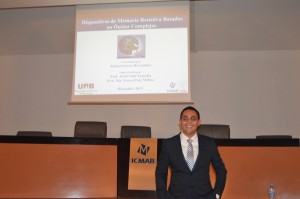 Rafael Ortega defended his PhD Thesis, entitled “Memorias Resistivas basadas en óxidos complejos”, the jury formed by Juan Antonio Rubio Solá, Juan Bautista Roldán Aranda and Luis Eduardo Hueso Arroyo awarded his work with an Excellent for a PhD thesis at the Universitat Autònoma de Barcelona.
Congratulations Rafael!
Rafael Ortega defended his PhD Thesis, entitled “Memorias Resistivas basadas en óxidos complejos”, the jury formed by Juan Antonio Rubio Solá, Juan Bautista Roldán Aranda and Luis Eduardo Hueso Arroyo awarded his work with an Excellent for a PhD thesis at the Universitat Autònoma de Barcelona.
Congratulations Rafael!
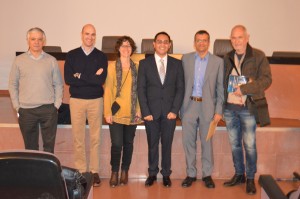
Epitaxial YBa2Cu3O7−x nanocomposite thin films from colloidal solutions
Written by Albert Moreno on . Posted in Scientific Highlights.
 P Cayado, K De Keukeleere, A Garzón, L Perez-Mirabet, A Meledin, J De Roo, F Vallés, B Mundet, H Rijckaert, G Pollefeyt, M Coll1, S Ricart, A Palau, J Gázquez, J Ros, G Van Tendeloo, I Van Driessche, T Puig and X Obradors.
IOP Publishing Ltd • Superconductor Science and Technology, Volume 28
A methodology of general validity to prepare epitaxial nanocomposite films based on the use of colloidal solutions containing different crystalline preformed oxide nanoparticles (ex situnanocomposites) is reported. The trifluoroacetate (TFA) metal–organic chemical solution deposition route is used with alcoholic solvents to grow epitaxial YBa2Cu3O7 (YBCO) films. For this reason stabilizing oxide nanoparticles in polar solvents is a challenging goal. We have used scalable nanoparticle synthetic methodologies such as thermal and microwave-assisted solvothermal techniques to prepare CeO2 and ZrO2 nanoparticles. We show that stable and homogeneous colloidal solutions with these nanoparticles can be reached using benzyl alcohol, triethyleneglycol, nonanoic acid, trifluoroacetic acid or decanoic acid as protecting ligands, thereby allowing subsequent mixing with alcoholic TFA solutions. An elaborate YBCO film growth analysis of these nanocomposites allows the identification of the different relevant growth phenomena, e.g. nanoparticles pushing towards the film surface, nanoparticle reactivity, coarsening and nanoparticle accumulation at the substrate interface. Upon mitigation of these effects, YBCO nanocomposite films with high self-field critical currents (Jc ~ 3–4 MA cm−2 at 77 K) were reached, indicating no current limitation effects associated with epitaxy perturbation, while smoothed magnetic field dependences of the critical currents at high magnetic fields and decreased effective anisotropic pinning behavior confirm the effectiveness of the novel developed approach to enhance vortex pinning. In conclusion, a novel low cost solution-derived route to high current nanocomposite superconducting films and coated conductors has been developed with very promising features.
P Cayado, K De Keukeleere, A Garzón, L Perez-Mirabet, A Meledin, J De Roo, F Vallés, B Mundet, H Rijckaert, G Pollefeyt, M Coll1, S Ricart, A Palau, J Gázquez, J Ros, G Van Tendeloo, I Van Driessche, T Puig and X Obradors.
IOP Publishing Ltd • Superconductor Science and Technology, Volume 28
A methodology of general validity to prepare epitaxial nanocomposite films based on the use of colloidal solutions containing different crystalline preformed oxide nanoparticles (ex situnanocomposites) is reported. The trifluoroacetate (TFA) metal–organic chemical solution deposition route is used with alcoholic solvents to grow epitaxial YBa2Cu3O7 (YBCO) films. For this reason stabilizing oxide nanoparticles in polar solvents is a challenging goal. We have used scalable nanoparticle synthetic methodologies such as thermal and microwave-assisted solvothermal techniques to prepare CeO2 and ZrO2 nanoparticles. We show that stable and homogeneous colloidal solutions with these nanoparticles can be reached using benzyl alcohol, triethyleneglycol, nonanoic acid, trifluoroacetic acid or decanoic acid as protecting ligands, thereby allowing subsequent mixing with alcoholic TFA solutions. An elaborate YBCO film growth analysis of these nanocomposites allows the identification of the different relevant growth phenomena, e.g. nanoparticles pushing towards the film surface, nanoparticle reactivity, coarsening and nanoparticle accumulation at the substrate interface. Upon mitigation of these effects, YBCO nanocomposite films with high self-field critical currents (Jc ~ 3–4 MA cm−2 at 77 K) were reached, indicating no current limitation effects associated with epitaxy perturbation, while smoothed magnetic field dependences of the critical currents at high magnetic fields and decreased effective anisotropic pinning behavior confirm the effectiveness of the novel developed approach to enhance vortex pinning. In conclusion, a novel low cost solution-derived route to high current nanocomposite superconducting films and coated conductors has been developed with very promising features.




